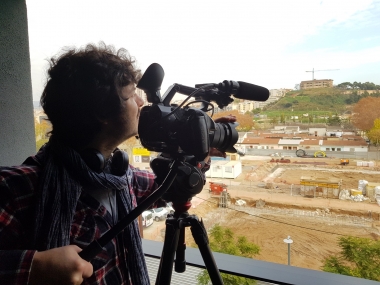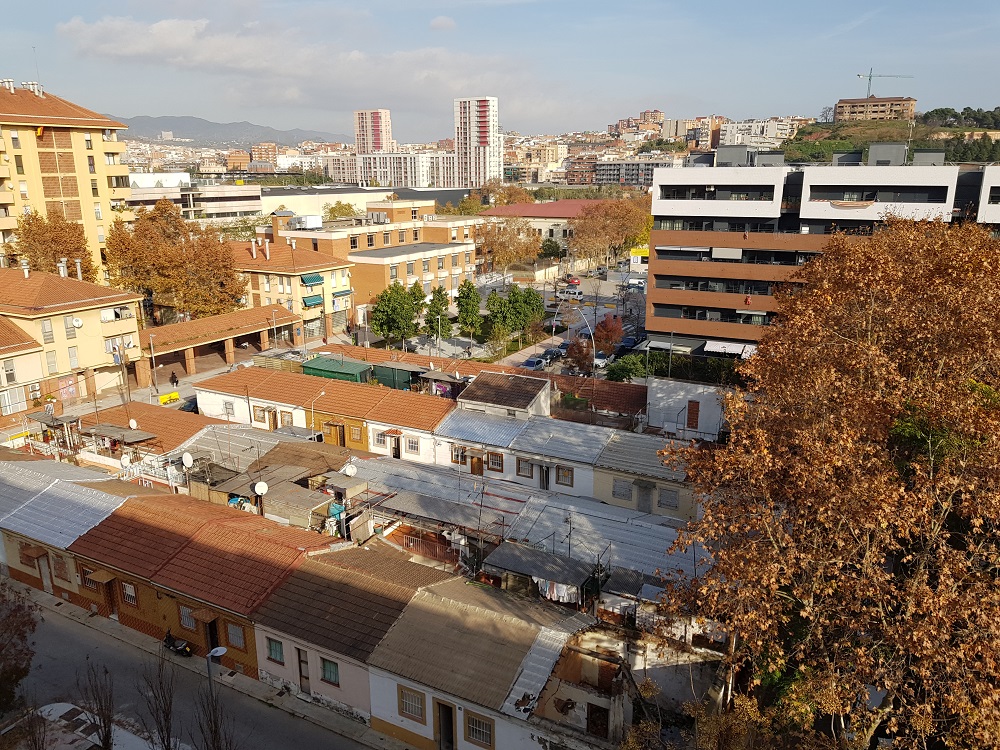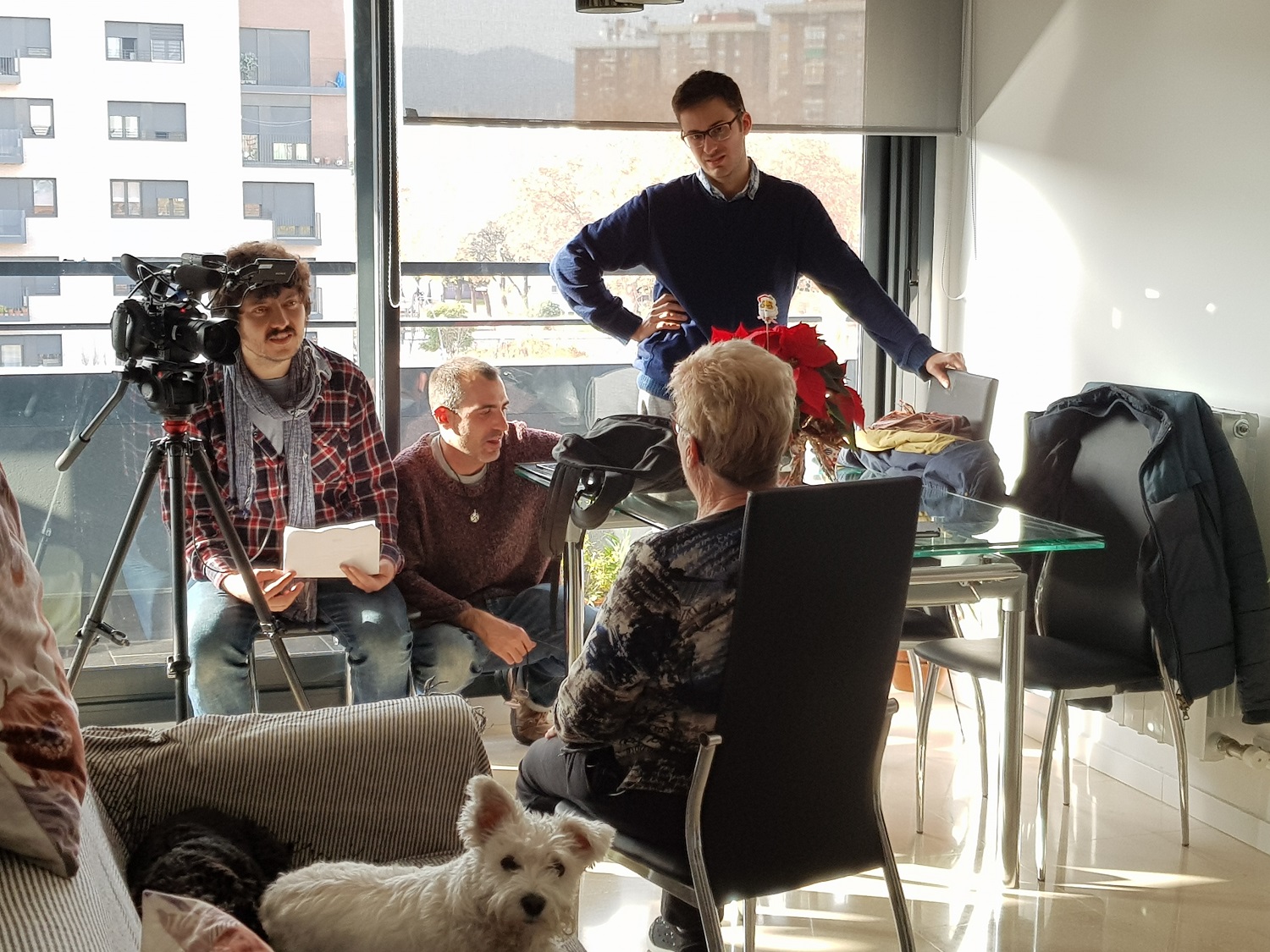The making-of of Bon Pastor case example video
Edited on
01 February 2019By Massimiliano Rumignani and Sebastià Riutort
 During December 2018, Albert Folk (a filmmaker specialised in documentary) and his assistant Adrián Boluda shot the video presenting the Barcelona case example of the “Accompanying program for the rehousing of residents from “Cases barates” of the El Bon Pastor neighbourhood”. Oriol Bosch and Sebastià Riutort (Social Rights Area, Barcelona City Council) and Massimiliano Rumignani (URBinclusion communication officer) assisted and accompanied them during the shooting.
During December 2018, Albert Folk (a filmmaker specialised in documentary) and his assistant Adrián Boluda shot the video presenting the Barcelona case example of the “Accompanying program for the rehousing of residents from “Cases barates” of the El Bon Pastor neighbourhood”. Oriol Bosch and Sebastià Riutort (Social Rights Area, Barcelona City Council) and Massimiliano Rumignani (URBinclusion communication officer) assisted and accompanied them during the shooting.

The mode of transportation you use to reach a destination impacts your perception of the place. The automated metro line that stops in Bon Pastor uses the most advanced technologies of the sector. And you note it, especially when you exit the station and start to walk around the neighbourhood and notice an evident contrast. The neighbourhood atmosphere is the one of a pretty quiet modest residential area, with some shops and an indoor market, with a civic centre and a public library, a large post-war period style church, and nearby schools. Some buildings look nice, which are rather new, others look quite old and some others even seem abandoned. After a while of walking through the Sant Adrià Street (one of the main streets) you notice a noise in the distance. Getting closer to it makes you understand that the area has been going under an important restructuring for the last years or decades, and nowadays another relevant part is going to be rebuilt.
When Albert Folk prepares the camera and starts to shoot, people around look at us with curiosity. ‘What do you find  here that is so interesting and worth to be filmed?’ they might think while passing by going to work, walking the dog or the babies, going shopping to the market or the small local shops, or just chatting with other neighbours. This environment is not what you see looking at the works construction site and the dusty surrounding streets. The last remaining “cases barates” (old and damaged low-price houses) from the twenties of the XX century lay there, half of them are shut and half of them are still inhabited by people waiting to move to the new public apartments in the 5 or 6 floors under-construction buildings. The rehousing of those residents is not an easy process for them, when you have lived for the majority of your life (and even the whole life of your sons and daughters) in one ground floor house and in close contact with people living around you. Those small streets between the “cases barates” lines were not a separation, but an airy space bringing together people living there. It tends to create community living, allowing people to live with houses doors unlocked, to enter the neighbour’s house just saying hello and walking in to ask for rice, eggs or onions when you run out of them while cooking.
here that is so interesting and worth to be filmed?’ they might think while passing by going to work, walking the dog or the babies, going shopping to the market or the small local shops, or just chatting with other neighbours. This environment is not what you see looking at the works construction site and the dusty surrounding streets. The last remaining “cases barates” (old and damaged low-price houses) from the twenties of the XX century lay there, half of them are shut and half of them are still inhabited by people waiting to move to the new public apartments in the 5 or 6 floors under-construction buildings. The rehousing of those residents is not an easy process for them, when you have lived for the majority of your life (and even the whole life of your sons and daughters) in one ground floor house and in close contact with people living around you. Those small streets between the “cases barates” lines were not a separation, but an airy space bringing together people living there. It tends to create community living, allowing people to live with houses doors unlocked, to enter the neighbour’s house just saying hello and walking in to ask for rice, eggs or onions when you run out of them while cooking.
We went there to look at the accompanying program delivered by La Fàbrica, a social initiative cooperative established in the neighbourhood since the beginning of this decade. As mandate of the neighbours’ association and with the funds, coordination and supervision provided by the Barcelona City Council) La Fàbrica supports local residents to properly adapt to the new life style in large building with shared spaces, to prevent possible conflicts linked to this new location, to maintain and try to strengthen community ties that were existing in the previous accommodations.
When local inhabitants ask us why we are filming and we explain that it is for making a video for the URBinclusion European project, we understand that we are rather coming from another planet since the distance is too big to be covered by a thirty seconds explanation. But when we add that it is to testify the work of the Municipality and La Fàbrica then everything changes. It especially occurs when we mention the name of Aritz Garcia. On behalf of La Fàbrica, he is implementing the program and he turned into its most visible face, with the permission of Miquel Àngel Lozano, responsible of this program and the neighbourhoods plan of Bon Pastor i Baró de Viver on behalf of the Municipality. Both are very sensitive to local needs and problems. But, due to his tasks, Aritz embodies an authentic community referent since he is in close and daily contact with local inhabitants: facilitating the relocation, supporting people to properly understand all implications of such change and helping them to solve possible and emerging problems.
 When we crossed with locals, we realise that they are interested in telling us their story. When you informally talk to them and ask them opinions, they are willing to share their difficulties, good and bad experiences. Thus, we understand what this program means for them. When Albert switches on the camera to interview them, they speak honestly and clearly, but the speech is rather more formal. They are happy and proud of having the possibility to make their voice heard. But it would be untrue saying that all of them behave this way.
When we crossed with locals, we realise that they are interested in telling us their story. When you informally talk to them and ask them opinions, they are willing to share their difficulties, good and bad experiences. Thus, we understand what this program means for them. When Albert switches on the camera to interview them, they speak honestly and clearly, but the speech is rather more formal. They are happy and proud of having the possibility to make their voice heard. But it would be untrue saying that all of them behave this way.
As in every human place, you find different people. Conflictive and frustrated people as well. And you are there to learn also from them and try to understand why and how they arrived at that state. Sometimes it seems impossible and you find an invisible wall that will never crumble away. Public workers on the ground already know that.
You walk around moving from one place to another following the video script and you understand the fact that the neighbourhood has a lively community, especially walking with Aritz that obligates us to stop every 20 metres because people want to talk to him (and he with them!). Sometimes just to say hello, some others to ask clarifications on specific issues. Once he is stopped by a new comer you understand that he faces continuous challenges to properly answer to the multiplicity of different questions and varied perspectives of neighbours. It is his role to understand the problems people face and try to help to solve them, maybe only few times acting directly, but mostly suggesting and facilitating a joint solution with neighbours.
When we enter one of the new buildings and a new flat, we understand also the results of the program. It  is not easy to pass living from horizontal houses to vertical ones, where you are obliged to share common spaces, previously completely unknown, and take care of them in a collaborative way without the community feeling experienced before. In the “cases barates” they did not share the responsibility for using and preserving the building common spaces and installations as in the new buildings, but they shared something much deeper and more personal, able to fill and warm up their not always easy lives. By listening to a resident from the new buildings it is clear that the process of adaptation is not that easy. People that have already moved miss something, in spite of the beautiful new accommodation. Albert asks clever and simple questions, but it is not always easy to share the own experience, especially when other people want to clearly understand the process you have gone through, the kind of your past expectations and current concerns.
is not easy to pass living from horizontal houses to vertical ones, where you are obliged to share common spaces, previously completely unknown, and take care of them in a collaborative way without the community feeling experienced before. In the “cases barates” they did not share the responsibility for using and preserving the building common spaces and installations as in the new buildings, but they shared something much deeper and more personal, able to fill and warm up their not always easy lives. By listening to a resident from the new buildings it is clear that the process of adaptation is not that easy. People that have already moved miss something, in spite of the beautiful new accommodation. Albert asks clever and simple questions, but it is not always easy to share the own experience, especially when other people want to clearly understand the process you have gone through, the kind of your past expectations and current concerns.
At the end, we left the area with the feeling that also shooting this video has been a small contribution to the process to support these residents to radically change their way of living. It is pretty clear that the strategy implemented has been successful, but the way ahead is still long until the end of the whole process. Past mistakes and good decisions are helping the program committed workers to improve their activities and results.
Submitted by Massimiliano Ru... on
